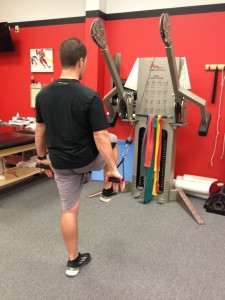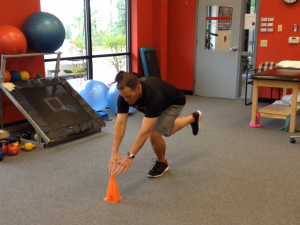Brian Schiff’s Blog
Injury Prevention, Sports Rehab & Performance Training Expert
In the majority of patients I see with knee pain or knee dysfunction, I uncover gluteal weakness and poor proximal muscular stability. This can cascade into overpronation, vagus collapse, poor balance, and any number of kinetic chain issues. While this may not be a big deal for sedentary individuals, it becomes a very big deal for athletes and those performing repetitive loading.
When searching for the best exercises to selectively strengthen the gluteal muscles, it is always wise to see what science has to say. More is not always better. I am all for efficiency and finding the most effective exercises in activating the glute over the tensor fascia lata (TFL). In this post, I am sharing a good exercise to do just that. Prior research has indicated that sidestepping and clamshells are very effective in doing just this. Click here to read a prior post on this.
The video below will walk you through his to do the running man exercise.
Click here to read my PFP column on this exercise.
Improving proximal hip stability and reducing frontal plane collapse is critical for protecting the knee. Poor frontal plane control often contributes to anterior knee pain, IT band syndrome, shin splints, plantar fasciitis and other injuries. This exercise is an advance progression of the standing pallof press, and it is very effective for enhancing single leg strength as well as hip/core stability.
Click here to read my full column on this exercise in PFP Magazine.
Whether doing prehab, rehab or training, I believe in using single leg exercises to attack asymmetries, imbalances and motor deficits I uncover in my assessments. Learning to control one’s body in space with the effect of gravity in a weight bearing position is instrumental for sport and injury prevention.
Furthermore, facilitating ankle mobility and proper knee alignment during a loaded squat pattern is something most athletes and clientele I work with need some help with. to that end, I utilize several different single leg reaching progressions and exercises. One of my favorite ‘go to’ exercises is the anterior cone reach.
I recently featured this specific exercise in my ‘Functionally Fit’ column for PFP Magazine. Click here to see the video demonstration.
This is a great exercise with progressions and regressions for clients of all ages and abilities.
Facilitating better lower leg stability is always a priority in my rehab and training programs. I have long been an advocate of single leg training to resolve asymmetry and reduce compensations and injury risk. Once a client masters form on the ground, adding in more proprioceptive challenges can take their training to a new level.
Today I wanted to share a previously unpublished video I shot for my ‘Functionally Fit’ column that demonstrates a single leg squat exercise on the BOSU Elite Trainer. It is a relatively new exercise tool that offers some tweaks on the original BOSU balance trainer.
This post is the third corrective exercise in a series I am doing for Personal Fitness Professional Magazine in my online column titled “Functionally Fit.” To read more online exercise tips, visit www.fit-pro.com.
The hurdle step assessment (as part of the FMS) is designed to challenge the body’s proper stepping and stride mechanics as well as stability & control in single leg stance. The step leg must perform ankle DF and hip/knee flexion while core stability must be present in single leg stance.

Limited hip mobility and/or poor hip and core stability restricts natural movement and leads to compensatory motion often in the form of unwanted hip rotation, hip hiking, trunk sway in the frontal and sagittal plane. A common corrective exercise prescribed to improve core stability is a standing march (single leg stance) with straight arm pulling to engage the core.
Execution: Begin standing with the feet together while holding the cable handles with the palms down. Select a weight that provides ample enough resistance to maintain isometric shoulder extension for 30-60 seconds. Be careful not to select too little or too much weight as this will disrupt the execution of the exercise.
Next, pull the arms down toward the side and hold in that position. Maintaining an erect posture, slowly lift the left leg up (ankle dorsiflexion with knee and hip flexion) and pause for 2-3 seconds. Move the unsupported leg back to the start position but keep the arms actively extended. Repeat this sequence for 10 times on the left leg. Rest for 30-60 seconds and then repeat on the other leg. Perform 2 sets.

Additional notes: I tend to focus on unilateral consecutive repetitions (as described above) especially if there is a 2/1 asymmetry with the hurdle step. As the asymmetry is resolving, I will progress to a reciprocal pattern as this is more natural in life/sport. If a cable column is unavailable, alternate methods include using a suspension training apparatus or resistance tubing anchored high enough to accomplish the same upper body isometric pulling.
Application: Poor hip stability and control in single leg stance is a common cause of overuse injuries in runners and contributes to increased risk for anterior knee pain and ACL injuries. Keep in mind that poor performance on the hurdle step movement can be related to weak hip flexors on the stepping leg, tight hip flexors on the stance leg, diminished hip stability and poor balance.
It is critical to assess the whole movement prior to assuming that there is just one problem or weak link in the kinetic chain. Restoring symmetric, optimal stepping patterns will promote proper hip disassociation, as well as training the body to synergistically activate core and hip musculature to demonstrate optimal single leg stability in unilateral stance.


